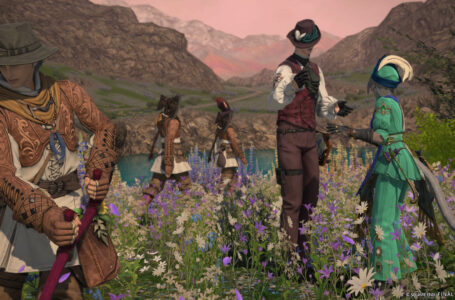The Returner: Stormblood’s postgame sets a new bar for single-player encounters
I’ve been working my way through Stormblood’s “postgame”, and I’ve been very impressed by how many super-cool single-player sequences there have been so far — even in comparison to the already high bar the game set in this regard.
Final Fantasy XIV is, of course, a massively multiplayer online game, but one of its most interesting aspects is how solo-friendly a lot of it is. This is one of the main reasons why people are happy to describe it as one of the best mainline Final Fantasy games of all time, whereas its spiritual predecessor Final Fantasy XI is often forgotten about, despite still being up and running a full twenty years after its original release.
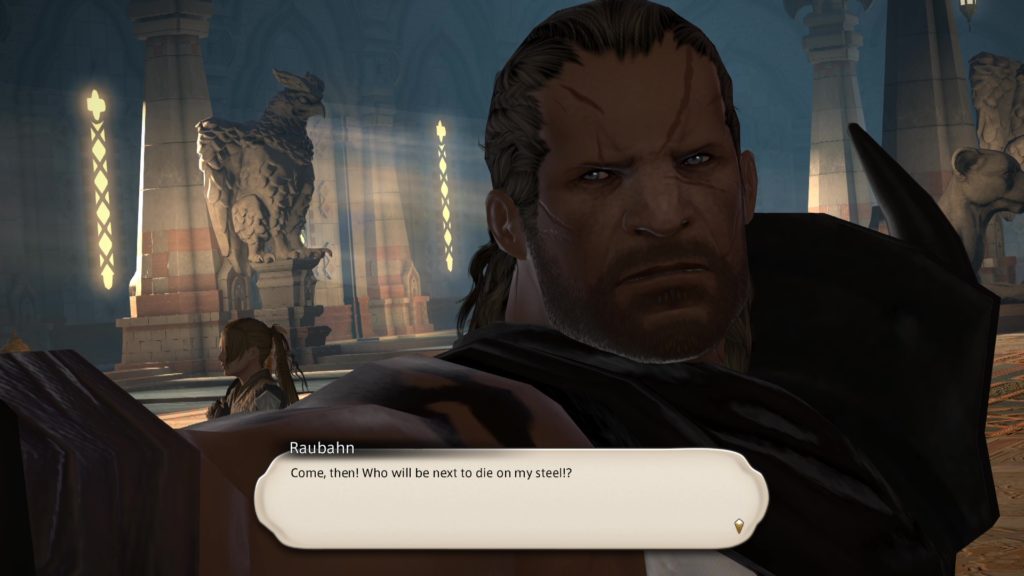
For those yet to dip their toes into the wonderful world of Final Fantasy XIV, the game, like most MMOs, features a blend of open-world action and instanced content, with the latter meaning that you (and, in many cases, a party of between three and twenty-three companions) are whisked away to a self-contained area in which something interesting happens without potential interference from other players. Final Fantasy XIV incorporates several different types of instance: four-player dungeons, eight-player Trials and raids, twenty four-player alliance raids — and the kind we’re primarily interested in today, the single-player instance.
Final Fantasy XIV’s use of single-player instances is one of the things that makes it stand out quite notably from many of its competitors, because in many other MMOs, solo content typically unfolds out in the open world, while the instanced content — inevitably some of the most spectacular stuff in the game — is reserved for party-based shenanigans of one form or another.
The use of single-player instances allows for things that would not normally be possible either in the open world or in multiplayer instances: most notably, the ability to cooperate with computer-controlled characters who would otherwise simply be NPCs in cutscenes, as well as a feeling that whatever job you’re playing as, you are the focal point of the entire encounter.
Final Fantasy XIV makes use of single-player instances right from the earliest hours of A Realm Reborn, but it’s in Stormblood’s postgame that they really come into their own; there’s the distinct impression that many of these sequences are laying the foundation for the Trust system that first appears in Shadowbringers, allowing you to run dungeons with story characters rather than human players.
There are two particular highlights in this regard that I’ve seen so far: a rematch against Sri Lakshmi, who was a major trial in Stormblood’s pre-level 70 story, and a battle where you need to quell the rage of a beloved character who, through a convoluted series of unfortunate circumstances, has ended up succumbing to his aramitama.
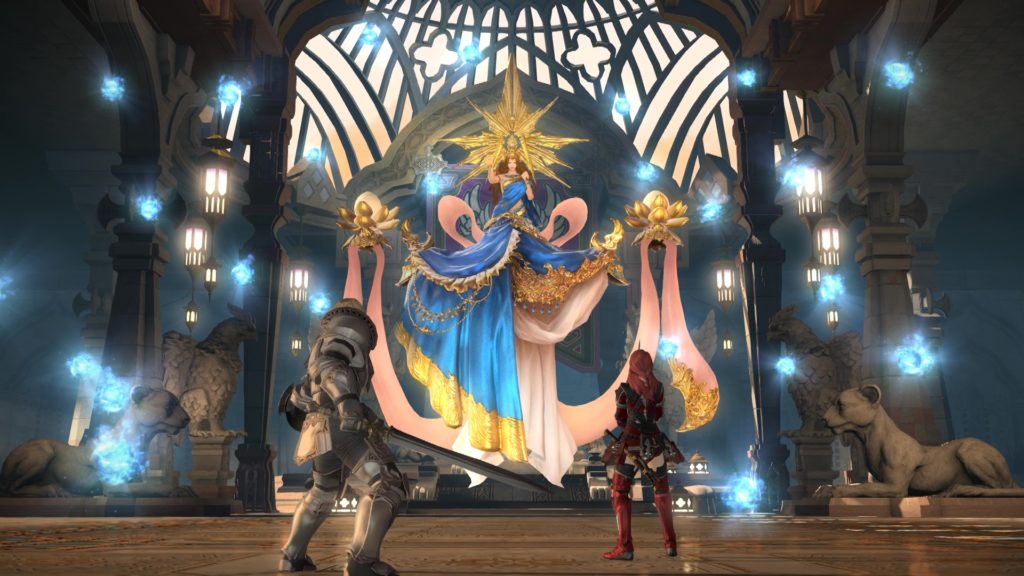
In the first case, the battle immediately establishes itself as being something very different from a conventional “tank and spank” sort of affair. In fact, in the opening moments you won’t be doing much attacking at all; instead, you need to prevent balls of aether that Lakshmi is shooting from reaching your companions, since unlike your Echo-powered self, they are not immune to her “tempering” process. This sequence unfolds rather akin to the classic arcade game Missile Command, in which you make use of the temporary “Duty Action” ability to trigger blasts around yourself, destroying the balls of aether in the process.
As the fight progresses, you start having to get some hits in on Sri Lakshmi herself, but there are frequent moments where you have to stop and deal with her pesky balls all over again. This gives the whole battle a really interesting feel as you run back and forth between your different responsibilities; in most multiplayer fights, you tend to be able to focus on your own role exclusively, but here you initially only have the backup of a single ally, so you end up having to take care of almost everything.
This fight was supposedly so difficult on its original release that it had to be nerfed quite a bit, as it was preventing a significant number of players from progressing in Stormblood’s main story! Now, it’s challenging but manageable — and it’s definitely a thrill, particularly with the way your tactical situation changes somewhat as the entire encounter progresses. It’s very cinematic and dramatic — and it works because it’s heavily scripted as a single-player encounter rather than something specifically intended to be multiplayer-centric.
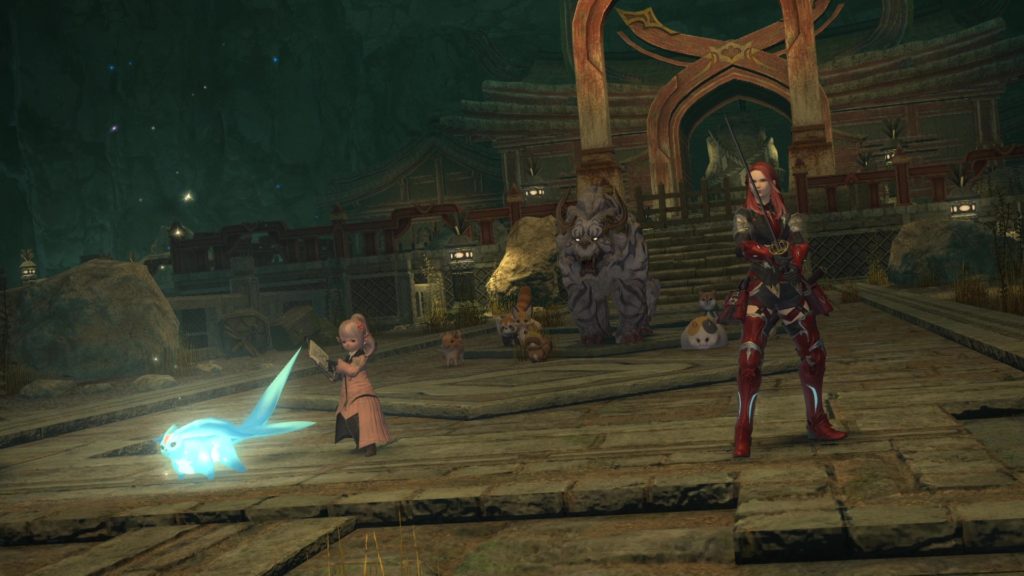
The second example was highly entertaining for different reasons — in this case, the way that the AI was deliberately made to be “bad” at the fight. Without spoiling story specifics, the context of the battle means that you’re standing alongside the diminutive Tataru to fight; she’s not terribly confident in her abilities as an Arcanist, but she knows that she needs to do her best in order to support you under these challenging circumstances.
Except partway through the battle, she absolutely panics and starts doing all the mechanics “wrong”. She gets a circular AoE marker following her? She heads right for you. She gets an attack aimed at her? She aims it right at you. She’s not being malicious, she’s just panicking and rushing to you for support — and perhaps to hide behind you now that she doesn’t feel quite so confident.
This sequence works precisely because it’s a single-player encounter. In multiplayer situations, if someone runs at you with an AoE marker, you’ll assume they’re unfamiliar with the fight, bad at the game or just trolling. In a single-player scenario, however, you know that Tataru’s behaviour is, in essence, part of the fight’s “mechanics”; as well as avoiding the regular attacks from the boss you’re supposed to be beating down, you also need to pay attention to what she’s up to, even though she isn’t your “enemy” as such.
Sequences like this are an absolute delight, because not only does it mean there are interesting things for the solo player to do, this specific example can also be looked upon as a wry, sidelong glance at the behaviour of real players. Most Final Fantasy XIV players have encountered someone who reacts like Tataru at one point or another — particularly earlier in the game, pre-Stormblood — and this sequence is a nice acknowledgement that very few of us started out playing the game “perfectly”; we all had to practice and learn the encounters in order to get good.
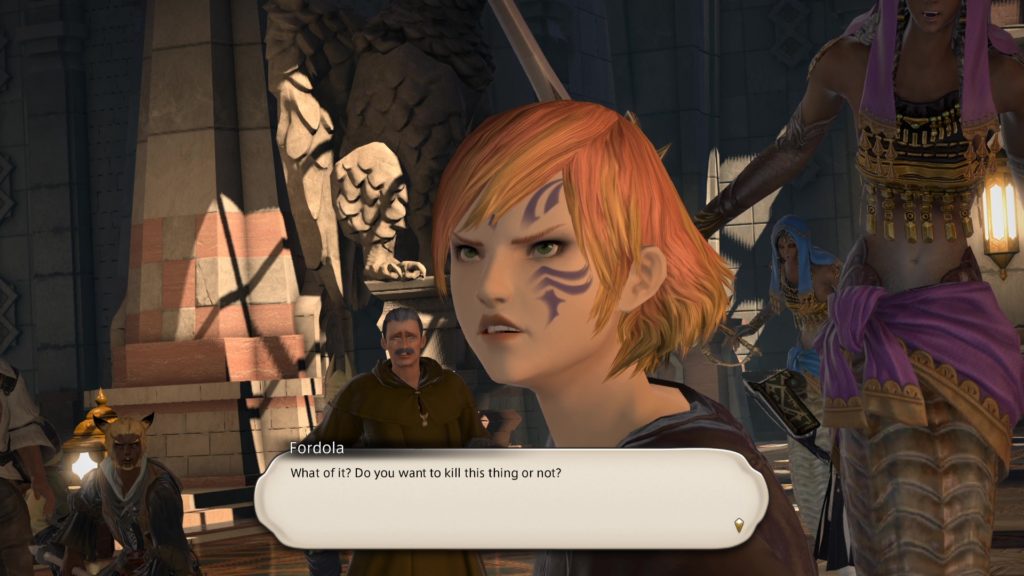
The convincing behaviour of the allies in both of these single-player instances makes me thoroughly intrigued to try out Trusts once I’m into Shadowbringers, as the ability to delve into dungeons with computer-controlled allies who know how to do mechanics means that the story will be able to flow much more easily — much less stopping to queue for things, in other words!
And it’s clear that this part of Stormblood’s postgame was very much a case of experimenting to see what would likely work in the new expansion. This has, after all, tended to be the pattern for the game as a whole; later Heavensward patches introduced elements like the button-bashing Active Time Maneuvers and mid-battle cinematic sequences, for example, and these put in regular appearances in fights from Stormblood onwards.
At this stage I can only imagine what Shadowbringers’ postgame will gradually introduce ahead of Endwalker, but one thing’s for certain: I cannot wait to find out. It’s fair to say that my enthusiasm for the game is well and truly renewed, and I look forward to my next session on Stormblood’s postgame with gleeful, eager anticipation for sure.
Join The Discussion
Rice Digital Discord
Rice Digital Twitter
Rice Digital Facebook
Or write us a letter for the Rice Digital Friday Letters Page by clicking here!
Disclosure: Some links in this article may be affiliate links, which means we may earn a small commission if you make a purchase after clicking on them. This is at no additional cost to you and helps support Rice Digital!
- Letter from the Editor: passing the torch - June 30, 2023
- Super Woden GP 2 is looking promising - June 30, 2023
- Inti Creates is making a 32 bit-style Love Live action platformer - June 26, 2023





